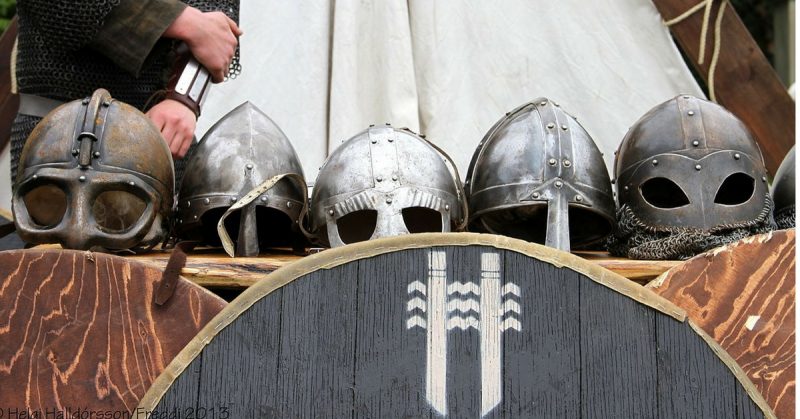The Byzantines Hired Viking Mercenaries as Guards
The relationship between the Byzantine Emperors and their Varangian Guard was a complex affair. The Byzantines were first introduced to their soon-to-be guardsmen during the tenth and eleventh centuries in a prolonged series of wars against the Rus, whose land centered around Kiev.
Vikings had been spreading from the Baltic Sea, along the river systems, all the way to the Black Sea. According to Michael Howard, in Transnationalism in Ancient Medieval Societies, the Norsemen set up centers for commerce and raiding: the Swedish in Novgorod and the Norwegians in Kiev, where they merged with the local Slavic culture to create new groups of people, including the Rus.
The Byzantine Emperors soon saw these river routes as important points of interest. In De Administrando Imperio, written between 948 and 952 C.E., the Emperor Constantine VII Porphyrogenitus (The Purple-born) made sure the routes from Novgorod to Kiev, and emerging at Constantinople, were studied and understood. Written for his son, it says, “The monoxyla [dugout vessels of varying sizes] which come down from outer Russia to Constantinople are from Novgorod…
All these come down the river Dnieper and are collected together at the city of Kiev.” The combatants soon became partners during the reign of Emperor Basil II (976-1025), and eventually, the Byzantine Emperors began a tradition of hiring mercenaries of Viking origin. The Byzantine mercenary entity of Rus, Scandinavians, Normans and Anglo-Saxons, became known as the Varangian Guard.
The guardsmen filled important roles as elite infantry and loyal Imperial Guardsmen, and in exchange, the Byzantine Emperors placed upon the Varangians great prestige and wealth.
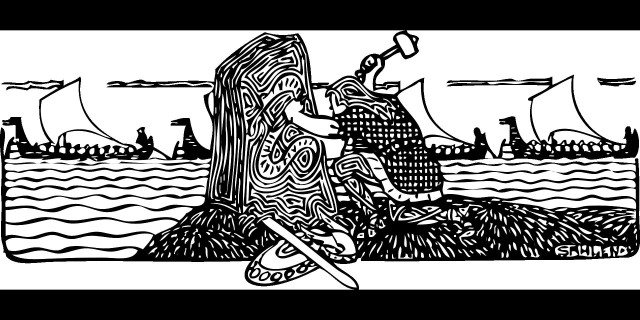
A Rough Introduction
When the Rus first arrived at the border of the Byzantine Empire, they were not there to make friends, nor did they leave a pleasant first impression on their Greek neighbors. By the ninth century, the Rus had begun emerging in the region of the Black Sea, trading, and raiding. Photius, the Patriarch of the Christian Church in Constantinople, displayed the distress that the Russ imposed on the Byzantines. He writes:
“Where is the Christ-loving emperor? Where are the armies? Where are the arms, the engines, the military deliberations and preparations?… As for this fierce and barbarous Scythian tribe, having crawled out of the very outskirts of the city, like a wild boar it has devoured all round about. Who will defend us? Who will array himself against this foe?”
According to John Haldon, in The Byzantine Wars, Emperor John I of the Byzantine Empire defeated a large Rus threat led by Svyatoslav, but seeing the value of Russian trade, allowed commerce to continue with the Rus of Kiev. The Rus repeatedly attacked the Byzantines from the late ninth century to the mid-eleventh century.
According to Raffaele D’Amato’s The Varangian Guard, the Rus made three major incursions against Constantinople: first in 860 C.E. and again in 907 C.E, which resulted in a treaty that allowed the Rus to serve as Byzantine mercenaries. They attacked Constantinople a third time in 941 C.E., and they made an attempt to attack Constantinople as late as 1043 C.E. The Rus were fended off by the Byzantines each time, and usually died from Greek fire, a devastating combustible liquid similar in nature to a flame thrower.
Michael Psellus writes in Chronographia, “Russian vessels, almost too numerous to count, either slipping past the intercepting squadrons that had long kept them at bay, or forcing their way in, occupied the Propontis.” Psellus mentions the Rus demanded “a thousand slaters for each ship” and notes that this is an impossible demand. Psellus then goes on to describe the Byzantine defense. The emperor equipped his own ships with “a generous supply of Greek fire” and sent them to face the longship blockade.
The Byzantine ships engaged the Rus, where, “Greek fire, too, was hurled at them, and the Russians, being unable to see now, then threw themselves into the water, trying to swim back to their comrades, or else, at a loss what to do, gave up all hope of escape.” Though the Byzantines were able to fend off the Russian advances, the Russians, nevertheless, obtained a reputation of being competent warriors.
The leaders of the Byzantines and the Rus, who are thought to have begun the tradition of the Varangian Guard, were the Byzantine Emperor, Basil II, and the Kiev Grand Prince, Vladimir ‘The Great.’ Basil II, who became emperor after the death of John I in 976, faced one of the post-succession civil wars that is so common in Roman history.
Basil II sent to Vladimir ‘The Great’ for Rus assistance: the agreement led to Vladimir’s conversion to Christianity and a marriage agreement between Vladimir and Basil’s sister, Anna. Prior to his conversion, Vladimir had held the Norse faith, and The Russian Primary Chronicle notes that the Greeks often criticized the Rus over their faith.
In a fashion similar the Christianization of pagans in Scandinavia, The Russian Primary Chronicle tells of an event where a Greek man spoke to the Rus, saying, “These are not gods, but only idols of wood. Today it is, and tomorrow it will rot away.” Basil II’s request for aid from his Viking neighbors in 988 began the Varangian Guard that would serve as a loyal Imperial Guard for the Byzantine Emperors who were under constant threat of court intrigue and civil war.
The reliance of the emperors on the Varangians would increase Varangian pay and renown.
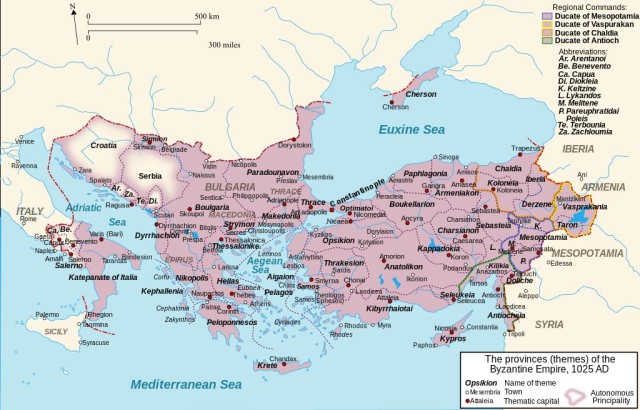
The Guard
The force that Vladimir ‘The Great’ sent to aid Basil II is seen to be the origin of the elite Varangian Guard. Raffaele D’Amato writes, “Vladimir’s contributions to the victories of Basil II led to a significant change in the imperial Guard.
The surviving Rus formed the nucleus of the imperial bodyguard which became known as the Varangian Guard.” The Varangians fit well into the Byzantine military system. The Byzantines wanted, according to John Haldon, a force of heavy infantry to work with heavy cavalry in a strong, but flexible and maneuverable, style of warfare. The Varangians fit the role of heavy infantry perfectly. Armed with Byzantine armor and their Viking swords, as well as Danish axes or other wide-blade pole arms, the Varangians were well defended and could deal out enormous damage.
The Vikings of the Varangian Guard were experienced in sailing and sea warfare and also served in the Byzantine Navy. They challenged any pirates that happened to float into Byzantine waters. The emperors could find many offensive uses for the Varangians, but their most common task was defensive: the physical protection of the emperor.
Perhaps more important to the emperors than Varangian fighting capabilities was the Varangian loyalty. Like all political figures, the emperors faced many threats. In tradition with Roman history, court intrigue was prevalent. Even Chinese visitors to Constantinople realized the peril in which emperors lived. The Chiu-t’ang-shu, written in the middle of the tenth century, muses over the Byzantine Emperors: “Their Kings are not permanent rulers, but they select men of merit.
If an extraordinary calamity visits the country, or if wind and rain come at the wrong time, he is deposed and another man is put in his stead.” The Varangians, the emperors hoped, would not be involved in the court intrigues present in Constantinople. Anna Comnena, daughter of Emperor Alexius I, writes in the Alexiad: “The Varangians, too, who carried their axes on their shoulders, regarded their loyalty to the Emperors and their protection of the imperial persons as a pledge and ancestral tradition, handed down from father to son, which they keep inviolate and will certainly not listen to even the slightest word about treachery.”
The emperors showed their gratitude to loyal guardsmen by paying the Varangians fortunes and, at times, even giving them access to the imperial treasure hoard. Snorri Sturluson’s Haralds saga SIgurdarson, about Harald Hardrada, a Norwegian King and Varangian leader, gives insight into the opportunities for wealth in the service of Constantinople. The Saga notes:
“No one in the Northlands had ever seen so much wealth in the possession of one man, for while he was in Mikligard [Constantinople], Harald had participated in “palace-pillaging” three times. It was the law there that when a Greek king died, the Varangians had pillaging rights at his palaces. They were permitted to go through all the king’s treasuries and each man could help himself freely to whatever he could lay his hands on.”
The emperor’s favoritism of the Varangian Guard also shows in the division of war plunder. After successes in warfare in the year 1016, the emperor divided the loot from Logon and the Pelagonian fields, keeping a third for himself, distributing another third among the Byzantine military, and handing the last third to the “Rhos” Varangians. In exchange for loyalty, the Varangian Guards were showered in wealth.
Though the Varangian Guard was known for its loyalty, they did sometimes favor some royal members over others. The Varangian, Harald Hardrada, expressed this in the Saga written about him. He had a bittersweet relationship with royal family after being imprisoned by the Emperor Michael V and Empress Zoe. Hardrada escaped, and with a band of Varangians, infiltrated the Emperor’s quarters and “seized the king, and put out both his eyes.”
The Varangians supported Zoe’s claim to the Byzantine Empire, but Hardrada refused to submit to her authority. As he escaped, he sent the cause of his imprisonment, a woman, back to Empress Zoe, “to point out to Zoe how little control she had over him.” Though Hardrada mocked her, the Varangians still showed loyalty to Empress Zoe by later supporting her claim to the Byzantine throne. She had been deprived of autonomy when married to Emperor Michael, as stated by Michael Psellus in his Chronographia:
“he proceeded to deny her any liberty whatsoever. Permission to leave the palace in her usual way was refused, and she was shut up in the women’s quarters. No one was allowed to approach her, unless the captain of the Guard had first given authority, after careful scrutiny of the visitor’s identity…. She restrained herself, reflecting that to rebel against Michael’s decision would be improper, and in any case she had no opportunity, even if she wished, to take any action or oppose his will, for she was deprived of all protection from the Imperial Guard and bereft of all authority. ”
Even though Hardrada claimed that he took out the eyes of Michael V and taunted Zoe, the Varangians still liberated Zoe and reasserted her authority as ruler of the Byzantine Empire. As long as the emperors showed loyalty and respect to the Varangians, the Varangians usually returned that respect and loyalty.
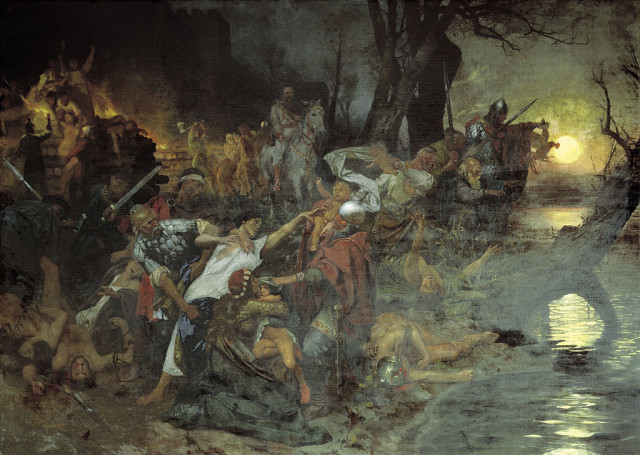
Power and Drunkenness
The wealth that the emperors bestowed upon the Varangians likely attributed to another negative trait associated with the guard—drunkenness. The Varangian Guard gained the name “the emperor’s wineskins” and could often be found frequenting brothels and Greek entertainment centers such as Constantinople’s Hippodrome, which hosted chariot races.
The common Byzantines also criticized Varangians because, as the emperor’s loyal favorites, they were often used as imperial police, carrying out arrests and serving as jailors. While the Varangian Guard fell to the same trappings as many other men, they, nevertheless, remained a highly respected and influential force. The leader of the Varangians was named Akolouthos, translated as ‘the follower;’ he acted as a right-hand-man to the emperor during the height of the Varangian Guard’s power, and was even trusted to take care of Constantinople while the emperor was away.
Varangian prestige and power outshined the visible aspects of the Guardsmen.
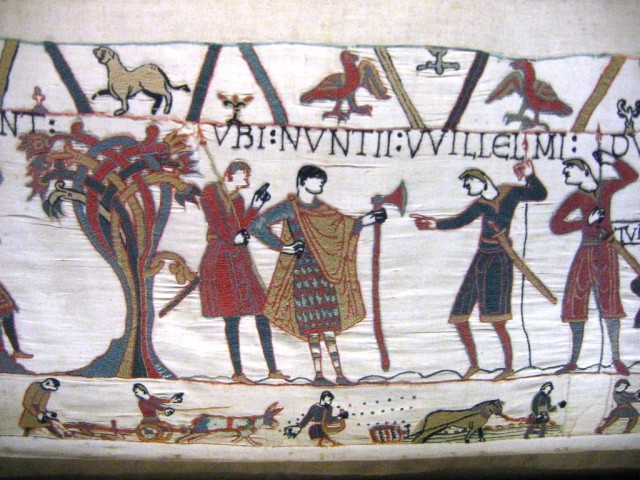
Cultural Diversity
The Varangians themselves were not just Rus. The Varangian Guard accepted members from most societies that had Scandinavian origin. Displaced Anglo-Saxons also found their way into the service of the Varangian Guard, especially after 1066, when the Normans became the dominant political power in England. Vikings often made promising mercenaries, as long as a ruler had money to pay them, for Viking mercenaries did not discriminate in whom they attacked based on religion, ethnicity, or the motivation of their employer.
The Byzantine Empire had no problem with hiring mercenaries as they had a wide array of foreign forces serving in their rosters. In “Allies of God or Man,” Niels Lund writes, “Foreign mercenary troops, especially of western knights—Franks, Germans and Normans—played an increasingly prominent role, usually under their own leaders…contemporaries continue to remark on the order, cohesion and discipline with which the multi-ethnic and colourful Byzantine armies fought.”
The more wars an emperor was required to fight, writes John Haldon, the more mercenaries he would have to recruit: “Alexios I’s army consisted almost entirely of mercenaries…employing Seljuk, Pecheneg or Cuman horse archers, Norman, German and French knights, Bulgarian and Anatolian light infantry, Georgians and Alans from the Caucasus, imperial guards recruited from outside the empire…its army became less ‘Byzantine.’”
Under Alexius I, the English Varangians were the more trusted of the elite mercenary company, and the numbers of Anglo-Saxons in Constantinople had increased to a level where English could be recognized in the streets of the capitol during the eleventh century.
An Elite Force
The Varangian Guard was a mercenary company within a mercenary military. Yet, the Varangians often went above the average call of duty required by mercenaries: “even in the worst moments of the Empire the Varangians showed a fidelity beyond that of all other regiments of the Imperial Guard.” The Varangians served wherever they were needed, which included a large variety of theaters of war.
The Saga of Harald Hardrada displays the variety of locations where Varangians could be expected to serve during their service under the emperor. Hardrada fought in Italy and Sicily, Palestine and Jerusalem, as well as typical Varangian Guard duty around Constantinople, ending his Varangian career with a total of eighteen significant battles. According to D’Amato, the Varangians took part in the campaigns against many of Byzantium’s enemies, including Sicily and Crete in the 960s, Basil II’s Syria campaign from 994-999, as well as his 1000-1001 campaign against Georgia and Armenia.
They were sent to Italian Bari several times in the early eleventh century, and sent to Egypt in 1033. They defended against the Seljuk Turks and the Normans. They participated in the disastrous battle of Manzikert against the Turks in 1071, tried to defend Constantinople against the Catholics during the Fourth Crusade in the early thirteenth century, and continued to serve the exiled emperors after the city was taken. The Varangian Guard served as the emperor’s loyal guard, elite infantry, naval assets, and a trusted police force in exchange for good wages and riches to plunder.
While the Varangians gave Byzantium military assistance, the Byzantines helped usher Christianity into the ranks of the Varangians. Vladimir ‘the Great’ converted to Christianity when he married Basil’s sister. By the end of the 11th century, most of the regions the Varangian Guard was recruiting from were Christianizing, leading to Varangian churches in Constantinople, such as the Panaghia Varanghiotissa, which was dedicated to Saint Olaf Haraldson.
The Varangian Guard benefited both the guardsmen themselves and the emperors they served. The pact between the Rus and the Byzantines helped to end the wars between the two groups which had been prevalent between the late tenth and early eleventh centuries. The emperors received a gravely needed loyal force that they could depend on to protect them from threats both outside and within.
The guardsmen themselves were able to accumulate enough wealth to literally buy themselves their own kingdoms, as was the case of Harald Hardrada. The weight of gold increased in the pockets of the Varangians as the weight of worry decreased upon the brows of the emperors.
By C. Keith Hansley
